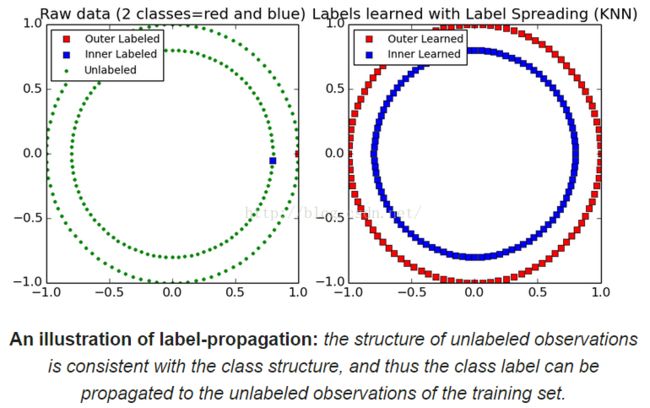- sklearn.ConfusionMatrixDisplay可视化混淆矩阵
Cachel wood
python机器学习和数据挖掘sklearn矩阵人工智能python机器学习vue.jsjava
文章目录ConfusionMatrixDisplay详细解释更多定制化ConfusionMatrixDisplayConfusionMatrixDisplay是scikit-learn库中用于可视化混淆矩阵的一个实用工具。混淆矩阵是一种常用的评估分类模型性能的工具,它可以直观地展示模型在各个类别上的预测结果与真实标签之间的关系。下面详细介绍如何使用ConfusionMatrixDisplay进行混
- 推荐学习图像处理的入门书:《Python图像处理实战》
天飓
学习感悟学习图像处理python
《Python图像处理实战》是一本全面介绍Python图像处理技术的实用指南,是由人民邮电出版社于2020年12月出版。这本书的作者桑迪潘·戴伊是一位兴趣广泛的数据科学家,主要研究机器学习、深度学习、图像处理和计算机视觉。在《Python图像处理实战》一书中,作者主要介绍了如何用Python图像处理库(如PIL、python-opencv、Scipy等),机器学习库(scikit-learn)和深
- Anaconda3 介绍和安装
gorgor在码农
#python入门基础pythonconda
介绍Anaconda是一个开源的Python和R语言发行版,专注于数据科学、机器学习和科学计算,主要面向数据科学和机器学习领域。它集成了大量常用的科学计算库(如NumPy、Pandas、Matplotlib、Scikit-learn等),并提供了强大的包管理工具Conda和环境管理功能,适合快速部署和管理复杂的开发环境。特点:预装丰富库:包含250+常用的数据科学工具包,无需手动安装。跨平台支持:
- Python编程笔记
我真不会起名字啊
python开发语言
关于python在安装第三方库时遇到的问题(numpy、matplotlib、scipy、scikit-learn)软件设计模式课程设计---Python实现学生信息管理系统(MySQL数据库+前端可视化)Python实现图形的几何变换(平移、旋转、错切、反射、缩放)Python实现三次参数样条曲线、三次Bezier曲线、三次B样条曲线(tkinter实现输入框,matplotlib绘制曲线)
- Python中的决策树算法探索
Soft_Leader
算法python决策树
在Python中,决策树算法是一种常用的机器学习技术,用于分类和回归问题。下面我们将探索如何使用Python中的scikit-learn库来实现决策树算法,并简要介绍其基本概念和用法。1.安装必要的库如果你还没有安装scikit-learn库,你可以使用pip来安装它:bash复制代码pipinstall-Uscikit-learn2.导入必要的库和模块python复制代码fromsklearn.
- sklearn_pandas.DataFrameMapper的用法
zoujiahui_2018
#Pytorchsklearnpandas人工智能
文章目录介绍主要作用基本用法示例对不同列应用不同的转换器对多列应用相同的转换器输出为PandasDataFrame注意事项转换器的适用性:输出格式:与scikit-learn的兼容性:介绍DataFrameMapper是sklearn-pandas库中的一个工具,主要用于将PandasDataFrame与scikit-learn的预处理工具无缝结合。它的作用是将DataFrame的列映射到特定的特
- Python与R机器学习(1)支持向量机
宠物与不尤编程
左手python右手R支持向量机机器学习pythonr语言
以下是对Python与R在支持向量机(SVM)实现上的核心区别分析及完整示例代码:一、核心差异对比特征Python(scikit-learn)R(e1071/kernlab)核心库sklearn.svm.SVC/SVRe1071::svm()或kernlab::ksvm()语法范式面向对象(先初始化模型后拟合)函数式+公式接口(y~x1+x2)核函数支持linear,poly,rbf,sigmoi
- 自定义数据集 使用scikit-learn中svm的包实现svm分类
灵封~
机器学习人工智能
引入必要的库importnumpyasnpfromsklearn.datasetsimportmake_classificationfromsklearn.model_selectionimporttrain_test_splitfromsklearn.svmimportSVCfromsklearn.metricsimportaccuracy_score,classification_report
- Python中的决策树算法探索基本原理
myCOTB
Python算法python决策树
Python中的决策树算法探索决策树是一种简单而直观的机器学习算法,广泛应用于分类和回归任务中。它通过对数据进行分割,构建一个树形结构,从而做出决策。本文将探讨决策树的基本原理,并演示如何使用Python中的scikit-learn库实现决策树算法。决策树的基本原理决策树的基本思想是通过对数据进行分割,逐步缩小数据的范围,从而使得每个叶节点(终节点)中的样本属于同一类别或具有相似的特征。决策树的构
- 自定义数据集 使用scikit-learn中svm的包实现svm分类
知识鱼丸
machinelearning人工智能
数据集生成:-使用make_classification函数生成包含1000个样本的数据集,设置20个特征,其中10个是有信息的特征,类别数为2,通过设置random_state=42保证每次运行生成的数据相同。数据划分:-使用train_test_split函数将生成的数据集划分为训练集和测试集,测试集占比为20%,同样通过random_state=42保证划分的一致性。SVM模型:-初始化SV
- scikit-learn实现SVM
PeterClerk
支持向量机scikit-learn算法
支持向量机(SVM)是一种监督学习算法,主要用于分类和回归分析。其基本原理是在数据集中找到一个最优的超平面,使得不同类别的数据被最大间隔分开。最大间隔超平面:SVM的目标是找到能够最大化训练样本间隔的超平面。间隔被定义为到最近训练样本点的距离,这些点被称为支持向量。这种策略的优势在于它提供了一种防止模型过拟合的方法,从而提高了泛化能力。核技巧:在实际应用中,许多数据集不是线性可分的,这就需要使用核
- 自定义数据集 使用scikit-learn中SVM的包实现SVM分类
Luzem0319
scikit-learn支持向量机分类
生成自定义数据集生成一个简单的二维数据集,包含两类数据点,分别用不同的标签表示。importnumpyasnpimportmatplotlib.pyplotasplt#生成数据np.random.seed(42)X=np.r_[np.random.randn(100,2)-[2,2],np.random.randn(100,2)+[2,2]]y=[0]*100+[1]*100#可视化数据plt.s
- 自定义数据集,使用scikit-learn 中K均值包 进行聚类
sirius12345123
scikit-learn均值算法
importmatplotlib.pyplotaspltfromsklearn.clusterimportKMeansimportnumpyasnpclass1_points=np.array([[1.9,1.2],[1.5,2.1],[1.9,0.5],[1.5,0.9],[0.9,1.2],[1.1,1.7],[1.4,1.1]])class2_points=np.array([[-1.9,1
- 自定义数据集 使用scikit-learn中svm的包实现svm分类
sirius12345123
scikit-learn支持向量机分类
importnumpyasnpimportmatplotlib.pyplotaspltfromsklearnimportsvm#定义数据class1_points=np.array([[1.9,1.2],[1.5,2.1],[1.9,0.5],[1.5,0.9],[0.9,1.2],[1.1,1.7],[1.4,1.1]])class2_points=np.array([[3.2,3.2],[3.
- 使用scikit-learn中的K均值包进行聚类分析
Luzem0319
机器学习人工智能
聚类是无监督学习中的一种重要技术,用于在没有标签信息的情况下对数据进行分析和组织。K均值算法是聚类中最常用的方法之一,其目标是将数据点划分为K个簇,使得每个簇内的数据点更加相似,而不同簇之间的数据点差异较大。准备自定义数据集首先,需要一个自定义数据集来进行聚类分析。importnumpyasnpimportpandasaspdimportmatplotlib.pyplotasplt#创建自定义数据
- 使用numpy自定义数据集,使用scikit-learn中SVM的包实现SVM分类
辞落山
numpyscikit-learn支持向量机
概述:支持向量机(SVM)是一种强大的分类算法,适用于线性和非线性分类问题。本博客将展示如何使用numpy自定义一个数据集,并利用scikit-learn中的SVM实现分类。1.导入必要的库importnumpyasnpfromsklearn.svmimportSVCfromsklearn.model_selectionimporttrain_test_splitfromsklearn.metri
- 【机器学习】自定义数据集,使用scikit-learn 中K均值包 进行聚类
加德霍克
机器学习scikit-learn均值算法python作业
一、K均值算法简介K均值算法的目标是将数据集划分为K个簇,使得每个数据点属于离它最近的簇中心(centroid)所代表的簇。K均值聚类算法步骤①初始化:随机选择原始数据的K个数据点作为初始质心(聚类中心)。②分配:将每个数据点划分到距离最近的质心所对应的簇中,即计算每个数据点到每个质心的距离,选择距离最近的质心作为该数据点所属的簇。③更新:重新计算每个簇的质心,即将该簇中所有数据点的坐标取平均值,
- 自定义数据集 使用scikit-learn中svm的包实现svm分类
Z211613347
python
importnumpyasnpimportmatplotlib.pyplotasplt#定义数据class1_points=np.array([[1.9,1.2],[1.5,2.1],[1.9,0.5],[1.5,0.9],[0.9,1.2],[1.1,1.7],[1.4,1.1]])class2_points=np.array([[3.2,3.2],[3.7,2.9],[3.2,2.6],[1.
- 用Python写一个ai agent采集,分析,预测工厂生产计划
朗韶智光
python人工智能
为了实现一个AI代理,我们需要使用Python的一些库,如pandas,numpy和scikit-learn。以下是一个简化的工厂生产计划采集、分析和预测的示例。首先,我们需要安装所需的库:```bashpipinstallpandasnumpyscikit-learn```然后,我们可以编写一个简单的AI代理,如下所示:```pythonimportpandasaspdimportnumpyas
- 自定义数据集,使用scikit-learn 中K均值包 进行聚类
〖是♂我〗
scikit-learn均值算法聚类
代码:#导入必要的库importmatplotlib.pyplotasplt#用于绘制图形fromsklearn.clusterimportKMeans#KMeans聚类算法importnumpyasnp#数值计算库#定义class1到class4的数据点,模拟四个不同的类(每个类7个二维点)class1_points=np.array([[1.9,1.2],[1.5,2.1],[1.9,0.5]
- 自定义数据集 使用scikit-learn中svm的包实现svm分类
〖是♂我〗
python开发语言
代码:importnumpyasnp#导入用于数值计算的库importmatplotlib.pyplotasplt#导入用于绘图的库#class1_points和class2_points分别定义了两个类别的数据点,二维坐标class1_points=np.array([[1.9,1.2],[1.5,2.1],[1.9,0.5],[1.5,0.9],[0.9,1.2],[1.1,1.7],[1.4
- python(scikit-learn)实现k均值聚类算法
嘿哈哈哈哈哈哈
机器学习聚类python算法机器学习人工智能
k均值聚类算法原理详解示例为链接中的例题直接调用python机器学习的库scikit-learn中k均值算法的相关方法fromsklearn.clusterimportKMeansimportnumpyasnpimportmatplotlib.pyplotaspltx=np.array([[0,2],[0,0],[1,0],[5,0],[5,2]])#计算k均值聚类kmeans=KMeans(n_
- Scikit-Learn K均值聚类
对许
#Python#人工智能与机器学习scikit-learn聚类机器学习
Scikit-LearnK均值聚类1、K均值聚类1.1、K均值聚类及原理1.2、K均值聚类的优缺点1.3、聚类与分类的区别2、Scikit-LearnK均值聚类2.1、Scikit-LearnK均值聚类API2.2、K均值聚类初体验(寻找最佳K)2.3、K均值聚类案例1、K均值聚类K-均值(K-Means)是一种聚类算法,属于无监督学习。K-Means在机器学习知识结构中的位置如下:1.1、K均值
- 【15-聚类分析入门:使用Scikit-learn进行K-means聚类】
是阿牛啊
机器学习回归预测大数据挖掘kmeans聚类python机器学习人工智能sklearn性能优化
文章目录前言K-means聚类的原理Scikit-learn中的K-means实现安装与导入生成模拟数据应用K-means聚类可视化聚类结果选择K的值总结前言 聚类分析是一种无监督学习方法,用于将数据集中的样本分组成若干个簇(cluster)。K-means是最广泛使用的聚类算法之一,其核心思想是将数据点分配到K个簇中,使得每个点到其簇中心的距离之和最小。在本文中,我们将介绍如何使用Scikit
- Scikit-learn提供了哪些机器学习算法以及如何使用Scikit-learn进行模型训练和评估
Java资深爱好者
机器学习scikit-learn算法
Scikit-learn库的使用一、Scikit-learn提供的机器学习算法Scikit-learn(通常简称为sklearn)是一个广泛使用的Python机器学习库,它提供了多种用于数据挖掘和数据分析的算法。Scikit-learn支持的机器学习算法可以大致分为以下几类:分类算法:支持向量机(SVM)随机森林(RandomForest)逻辑回归(LogisticRegression)朴素贝叶斯
- 使用Scikit-learn实现支持向量机分类器
清水白石008
pythonPython题库scikit-learn支持向量机python
使用Scikit-learn实现支持向量机分类器引言支持向量机(SupportVectorMachine,SVM)是一种强大的监督学习算法,广泛应用于分类和回归任务。SVM的核心思想是通过寻找一个最佳的超平面来分隔不同类别的数据点。本文将详细介绍如何使用Python的Scikit-learn库实现一个支持向量机分类器,包括数据准备、模型训练、评估和可视化等步骤。1.支持向量机的基本原理支持向量机的
- Python软体中使用Scikit-learn库训练简单线性回归模型
清水白石008
Python题库pythonpythonscikit-learn线性回归
Python软体中使用Scikit-learn库训练简单线性回归模型1.引言作为数据科学家和机器学习从业者,我们经常需要处理各种类型的数据,并从中提取有价值的信息。其中,线性回归是最基础也是最常用的机器学习算法之一。它可以帮助我们预测连续型目标变量,在很多实际应用场景中都有广泛应用,比如房价预测、销量预测等。在本文中,我将使用Python的Scikit-learn库,介绍如何训练一个简单的线性回归
- 自定义数据集使用scikit-learn中的包实现线性回归方法对其进行拟合
Jam-Young
python机器学习开发语言
自定义数据集使用scikit-learn中的包实现线性回归方法对其进行拟合importnumpyasnpimportmatplotlib.pyplotaspltfromsklearn.linear_modelimportLinearRegressionfromsklearn.model_selectionimporttrain_test_splitfromsklearn.metricsimport
- 使用scikit-learn中的线性回归包对自定义数据集进行拟合
Luzem0319
scikit-learn线性回归python
1.导入必要的库首先,需要导入所需的库,包括pandas用于数据处理,numpy用于数值计算,以及scikit-learn中的线性回归模型。importpandasaspdimportnumpyasnpfromsklearn.model_selectionimporttrain_test_splitfromsklearn.linear_modelimportLinearRegressionfrom
- 深入剖析 Scikit-learn 中的 LogisticRegression:参数调优指南
夜色呦
scikit-learn机器学习人工智能
LogisticRegression是一种广泛应用于二分类问题的机器学习算法。在scikit-learn库中,LogisticRegression类提供了一个高效且易于使用的实现。本文将深入探讨LogisticRegression的各种参数,并展示如何通过调整这些参数来优化模型的性能。1.LogisticRegression简介LogisticRegression通过使用逻辑函数将线性回归的输出映
- [星球大战]阿纳金的背叛
comsci
本来杰迪圣殿的长老是不同意让阿纳金接受训练的.........
但是由于政治原因,长老会妥协了...这给邪恶的力量带来了机会
所以......现代的地球联邦接受了这个教训...绝对不让某些年轻人进入学院
- 看懂它,你就可以任性的玩耍了!
aijuans
JavaScript
javascript作为前端开发的标配技能,如果不掌握好它的三大特点:1.原型 2.作用域 3. 闭包 ,又怎么可以说你学好了这门语言呢?如果标配的技能都没有撑握好,怎么可以任性的玩耍呢?怎么验证自己学好了以上三个基本点呢,我找到一段不错的代码,稍加改动,如果能够读懂它,那么你就可以任性了。
function jClass(b
- Java常用工具包 Jodd
Kai_Ge
javajodd
Jodd 是一个开源的 Java 工具集, 包含一些实用的工具类和小型框架。简单,却很强大! 写道 Jodd = Tools + IoC + MVC + DB + AOP + TX + JSON + HTML < 1.5 Mb
Jodd 被分成众多模块,按需选择,其中
工具类模块有:
jodd-core &nb
- SpringMvc下载
120153216
springMVC
@RequestMapping(value = WebUrlConstant.DOWNLOAD)
public void download(HttpServletRequest request,HttpServletResponse response,String fileName) {
OutputStream os = null;
InputStream is = null;
- Python 标准异常总结
2002wmj
python
Python标准异常总结
AssertionError 断言语句(assert)失败 AttributeError 尝试访问未知的对象属性 EOFError 用户输入文件末尾标志EOF(Ctrl+d) FloatingPointError 浮点计算错误 GeneratorExit generator.close()方法被调用的时候 ImportError 导入模块失
- SQL函数返回临时表结构的数据用于查询
357029540
SQL Server
这两天在做一个查询的SQL,这个SQL的一个条件是通过游标实现另外两张表查询出一个多条数据,这些数据都是INT类型,然后用IN条件进行查询,并且查询这两张表需要通过外部传入参数才能查询出所需数据,于是想到了用SQL函数返回值,并且也这样做了,由于是返回多条数据,所以把查询出来的INT类型值都拼接为了字符串,这时就遇到问题了,在查询SQL中因为条件是INT值,SQL函数的CAST和CONVERST都
- java 时间格式化 | 比较大小| 时区 个人笔记
7454103
javaeclipsetomcatcMyEclipse
个人总结! 不当之处多多包含!
引用 1.0 如何设置 tomcat 的时区:
位置:(catalina.bat---JAVA_OPTS 下面加上)
set JAVA_OPT
- 时间获取Clander的用法
adminjun
Clander时间
/**
* 得到几天前的时间
* @param d
* @param day
* @return
*/
public static Date getDateBefore(Date d,int day){
Calend
- JVM初探与设置
aijuans
java
JVM是Java Virtual Machine(Java虚拟机)的缩写,JVM是一种用于计算设备的规范,它是一个虚构出来的计算机,是通过在实际的计算机上仿真模拟各种计算机功能来实现的。Java虚拟机包括一套字节码指令集、一组寄存器、一个栈、一个垃圾回收堆和一个存储方法域。 JVM屏蔽了与具体操作系统平台相关的信息,使Java程序只需生成在Java虚拟机上运行的目标代码(字节码),就可以在多种平台
- SQL中ON和WHERE的区别
avords
SQL中ON和WHERE的区别
数据库在通过连接两张或多张表来返回记录时,都会生成一张中间的临时表,然后再将这张临时表返回给用户。 www.2cto.com 在使用left jion时,on和where条件的区别如下: 1、 on条件是在生成临时表时使用的条件,它不管on中的条件是否为真,都会返回左边表中的记录。
- 说说自信
houxinyou
工作生活
自信的来源分为两种,一种是源于实力,一种源于头脑.实力是一个综合的评定,有自身的能力,能利用的资源等.比如我想去月亮上,要身体素质过硬,还要有飞船等等一系列的东西.这些都属于实力的一部分.而头脑不同,只要你头脑够简单就可以了!同样要上月亮上,你想,我一跳,1米,我多跳几下,跳个几年,应该就到了!什么?你说我会往下掉?你笨呀你!找个东西踩一下不就行了吗?
无论工作还
- WEBLOGIC事务超时设置
bijian1013
weblogicjta事务超时
系统中统计数据,由于调用统计过程,执行时间超过了weblogic设置的时间,提示如下错误:
统计数据出错!
原因:The transaction is no longer active - status: 'Rolling Back. [Reason=weblogic.transaction.internal
- 两年已过去,再看该如何快速融入新团队
bingyingao
java互联网融入架构新团队
偶得的空闲,翻到了两年前的帖子
该如何快速融入一个新团队,有所感触,就记下来,为下一个两年后的今天做参考。
时隔两年半之后的今天,再来看当初的这个博客,别有一番滋味。而我已经于今年三月份离开了当初所在的团队,加入另外的一个项目组,2011年的这篇博客之后的时光,我很好的融入了那个团队,而直到现在和同事们关系都特别好。大家在短短一年半的时间离一起经历了一
- 【Spark七十七】Spark分析Nginx和Apache的access.log
bit1129
apache
Spark分析Nginx和Apache的access.log,第一个问题是要对Nginx和Apache的access.log文件进行按行解析,按行解析就的方法是正则表达式:
Nginx的access.log解析正则表达式
val PATTERN = """([^ ]*) ([^ ]*) ([^ ]*) (\\[.*\\]) (\&q
- Erlang patch
bookjovi
erlang
Totally five patchs committed to erlang otp, just small patchs.
IMO, erlang really is a interesting programming language, I really like its concurrency feature.
but the functional programming style
- log4j日志路径中加入日期
bro_feng
javalog4j
要用log4j使用记录日志,日志路径有每日的日期,文件大小5M新增文件。
实现方式
log4j:
<appender name="serviceLog"
class="org.apache.log4j.RollingFileAppender">
<param name="Encoding" v
- 读《研磨设计模式》-代码笔记-桥接模式
bylijinnan
java设计模式
声明: 本文只为方便我个人查阅和理解,详细的分析以及源代码请移步 原作者的博客http://chjavach.iteye.com/
/**
* 个人觉得关于桥接模式的例子,蜡笔和毛笔这个例子是最贴切的:http://www.cnblogs.com/zhenyulu/articles/67016.html
* 笔和颜色是可分离的,蜡笔把两者耦合在一起了:一支蜡笔只有一种
- windows7下SVN和Eclipse插件安装
chenyu19891124
eclipse插件
今天花了一天时间弄SVN和Eclipse插件的安装,今天弄好了。svn插件和Eclipse整合有两种方式,一种是直接下载插件包,二种是通过Eclipse在线更新。由于之前Eclipse版本和svn插件版本有差别,始终是没装上。最后在网上找到了适合的版本。所用的环境系统:windows7JDK:1.7svn插件包版本:1.8.16Eclipse:3.7.2工具下载地址:Eclipse下在地址:htt
- [转帖]工作流引擎设计思路
comsci
设计模式工作应用服务器workflow企业应用
作为国内的同行,我非常希望在流程设计方面和大家交流,刚发现篇好文(那么好的文章,现在才发现,可惜),关于流程设计的一些原理,个人觉得本文站得高,看得远,比俺的文章有深度,转载如下
=================================================================================
自开博以来不断有朋友来探讨工作流引擎该如何
- Linux 查看内存,CPU及硬盘大小的方法
daizj
linuxcpu内存硬盘大小
一、查看CPU信息的命令
[root@R4 ~]# cat /proc/cpuinfo |grep "model name" && cat /proc/cpuinfo |grep "physical id"
model name : Intel(R) Xeon(R) CPU X5450 @ 3.00GHz
model name :
- linux 踢出在线用户
dongwei_6688
linux
两个步骤:
1.用w命令找到要踢出的用户,比如下面:
[root@localhost ~]# w
18:16:55 up 39 days, 8:27, 3 users, load average: 0.03, 0.03, 0.00
USER TTY FROM LOGIN@ IDLE JCPU PCPU WHAT
- 放手吧,就像不曾拥有过一样
dcj3sjt126com
内容提要:
静悠悠编著的《放手吧就像不曾拥有过一样》集结“全球华语世界最舒缓心灵”的精华故事,触碰生命最深层次的感动,献给全世界亿万读者。《放手吧就像不曾拥有过一样》的作者衷心地祝愿每一位读者都给自己一个重新出发的理由,将那些令你痛苦的、扛起的、背负的,一并都放下吧!把憔悴的面容换做一种清淡的微笑,把沉重的步伐调节成春天五线谱上的音符,让自己踏着轻快的节奏,在人生的海面上悠然漂荡,享受宁静与
- php二进制安全的含义
dcj3sjt126com
PHP
PHP里,有string的概念。
string里,每个字符的大小为byte(与PHP相比,Java的每个字符为Character,是UTF8字符,C语言的每个字符可以在编译时选择)。
byte里,有ASCII代码的字符,例如ABC,123,abc,也有一些特殊字符,例如回车,退格之类的。
特殊字符很多是不能显示的。或者说,他们的显示方式没有标准,例如编码65到哪儿都是字母A,编码97到哪儿都是字符
- Linux下禁用T440s,X240的一体化触摸板(touchpad)
gashero
linuxThinkPad触摸板
自打1月买了Thinkpad T440s就一直很火大,其中最让人恼火的莫过于触摸板。
Thinkpad的经典就包括用了小红点(TrackPoint)。但是小红点只能定位,还是需要鼠标的左右键的。但是自打T440s等开始启用了一体化触摸板,不再有实体的按键了。问题是要是好用也行。
实际使用中,触摸板一堆问题,比如定位有抖动,以及按键时会有飘逸。这就导致了单击经常就
- graph_dfs
hcx2013
Graph
package edu.xidian.graph;
class MyStack {
private final int SIZE = 20;
private int[] st;
private int top;
public MyStack() {
st = new int[SIZE];
top = -1;
}
public void push(i
- Spring4.1新特性——Spring核心部分及其他
jinnianshilongnian
spring 4.1
目录
Spring4.1新特性——综述
Spring4.1新特性——Spring核心部分及其他
Spring4.1新特性——Spring缓存框架增强
Spring4.1新特性——异步调用和事件机制的异常处理
Spring4.1新特性——数据库集成测试脚本初始化
Spring4.1新特性——Spring MVC增强
Spring4.1新特性——页面自动化测试框架Spring MVC T
- 配置HiveServer2的安全策略之自定义用户名密码验证
liyonghui160com
具体从网上看
http://doc.mapr.com/display/MapR/Using+HiveServer2#UsingHiveServer2-ConfiguringCustomAuthentication
LDAP Authentication using OpenLDAP
Setting
- 一位30多的程序员生涯经验总结
pda158
编程工作生活咨询
1.客户在接触到产品之后,才会真正明白自己的需求。
这是我在我的第一份工作上面学来的。只有当我们给客户展示产品的时候,他们才会意识到哪些是必须的。给出一个功能性原型设计远远比一张长长的文字表格要好。 2.只要有充足的时间,所有安全防御系统都将失败。
安全防御现如今是全世界都在关注的大课题、大挑战。我们必须时时刻刻积极完善它,因为黑客只要有一次成功,就可以彻底打败你。 3.
- 分布式web服务架构的演变
自由的奴隶
linuxWeb应用服务器互联网
最开始,由于某些想法,于是在互联网上搭建了一个网站,这个时候甚至有可能主机都是租借的,但由于这篇文章我们只关注架构的演变历程,因此就假设这个时候已经是托管了一台主机,并且有一定的带宽了,这个时候由于网站具备了一定的特色,吸引了部分人访问,逐渐你发现系统的压力越来越高,响应速度越来越慢,而这个时候比较明显的是数据库和应用互相影响,应用出问题了,数据库也很容易出现问题,而数据库出问题的时候,应用也容易
- 初探Druid连接池之二——慢SQL日志记录
xingsan_zhang
日志连接池druid慢SQL
由于工作原因,这里先不说连接数据库部分的配置,后面会补上,直接进入慢SQL日志记录。
1.applicationContext.xml中增加如下配置:
<bean abstract="true" id="mysql_database" class="com.alibaba.druid.pool.DruidDataSourc

